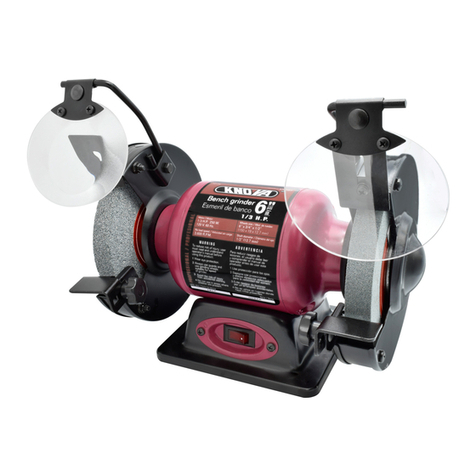
8
INDICE
Especificaciones .................................................................. 2
Reglas de seguridad importantes ........................................ 3
Conozca su esmeriladora de banco ...................................... 4
Instruciones de operación ................................................ 5-10
Mantenimiento ................................................................... 11
Resolución de problemas ............................................... 12,13
Explosivo y lista de partes ............................................. 14,15
Garantía .............................................................................. 16
SPECIFICATIONS
Modelo # KN 7060 KN 7070
Tipo de motor: Inducción Inducción
Valores de l motor: 120 V AC, 60 Hz 120 V AC, 60 Hz
Caballos de fuerza: 1/2 HP 3/4HP
Diámetro de rueda: 6” (150 mm) 8” (200 mm)
Espesor de rueda: 3/4” (20 mm) 1”(25 mm)
Agujero del eje: 1/2” (13 mm) 5/8” (15.88 mm)
Velocidad sin carga: 3,450 RPM 3,450 RPM
Disco abrasivo: 36 (Aspero) / 60 (Intermedio) 36 (Aspero) / 60 (Intermedio)
REGLAS IMPORTANTES DE SEGURIDAD
El no cumplimiento de alguna de las siguientes instru-ccio-
nes podría resultar en daños personales severos para el usuario
de la herramienta y quienes se encuentran en las cercanías o
provocar daños a la herramienta y a otros elementos !
PELIGRO
Lea, comprenda y respete todas las instrucciones en
este manual antes de utilizar u operar la herramienta para la
cual se ha escrito y con la que se ha provisto. Asegúrese de
que todo aquel que vaya a utilizar la herramienta haya leído y
comprendido las instrucciones provistas.
ADVERTENCIA
• Siempre utilice protección ocular que cumpla con un están-
dar reconocido (CSA o ANSI).
• Utilice una máscara o respirador cuando se genere polvo.
• Mantenga a los que se encuentran en la cercanía fuera del
área de trabajo mientras opera la herramienta.
• ¡Advertencia! Asegúrese siempre de que el área de trabajo
esté limpia de materiales inflamables, líquidos o gases dado que
el uso de esta herramienta puede producir chispas.
• Ajuste las tuercas de seguridad del disco abrasivo, asegu-
rando los pernos y todas las abrazaderas y protecciones.
• Durante cada encendido, póngase de pie al costado de la es-
meriladora y enciéndala. Deje que la esmeriladora opere a ve-
locidad máxima durante aproximadamente un minuto para que
cualquier falla o grieta no detectada se vuelva visible.
• Mantenga las protecciones en su lugar y funcionando adec-
uadamente.
• Mantenga sus manos lejos de los discos abrasivos.
• Nunca intente alcanzar por detrás o por debajo de los discos
abrasivos.
• Desenchufe de la fuente de alimentación antes de ajustar o
realizar un mantenimiento. Los discos abrasivos continúan gi-
rando luego de que la herramienta es apagada. Permita siempre
que los discos se detengan antes de ajustar o realizar un man-
tenimiento.
• Para evitar un shock eléctrico, NO utilice en condiciones
húmedas o expuestas a la lluvia.
• Cuando coloque un nuevo disco abrasivo, verifique siempre
que las RPM máximas indicadas coincidan o sean mayores de
aquellas indicadas en la esmeriladora. También verifique el nue-
vo disco en caso de daños, ya sea fallas o grietas. Si el disco
luce satisfactoriamente, colóquelo en la esmeriladora.
• Cuando se haya colocado un nuevo disco abrasivo, póngase
de pie al costado de la esmeriladora y enciéndala.
Deje que la esmeriladora opere a velocidad máxima durante
aproximadamente un minuto para que cualquier falla o grieta no
detectada se vuelva visible.
• Utilice únicamente accesorios que sean recomendados por el
fabricante para su modelo.
• NO intente cortar nada con el disco abrasivo.
• Las herramientas con descarga a tierra deben estar enchufa-
das a un toma corriente que haya sido debidamente instalado y
conectado con la descarga a tierra de acuerdo a todos los có-
digos y ordenanzas locales. Nunca retire la clavija de descarga
a tierra del enchufe o lo modifique en manera alguna. No utilice
enchufes adaptadores. Si tiene dudas con respecto a si él toma
corriente está adecuadamente conectado con la descarga a
tierra, consulte a un electricista calificado.
• No utilice esta herramienta cuando se encuentre cansado o
bajo la influencia de drogas, alcohol o medicación.
• No utilice ropa suelta o alhajas. Mantenga su cabello recogido.
• Asegúrese de que el interruptor se encuentra en “off” (apaga-
do) antes de enchufar la herramienta.
• ¡Advertencia! Reemplace discos abrasivos agrietados inme-
diatamente.
• No sobre ajuste las tuercas del eje.
• Ajuste los apoyos de herramienta cuando sea necesario para
mantener una distancia de 1/8” (3. 2 mm) del disco abrasivo.
• El mantenimiento de estas herramientas debería ser realizado
únicamente por un técnico autorizado y calificado.






























